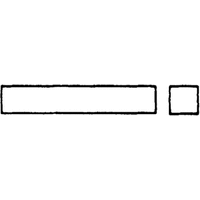H32 HAMLIN, H32 Datasheet

H32
Manufacturer Part Number
H32
Description
Magnet
Manufacturer
HAMLIN
Datasheet
1.H31.pdf
(2 pages)
Specifications of H32
Pull Force
1400G
Size
0.19 Square" X 1.00"
Leaded Process Compatible
Yes
For Use With
10-38 Ampere Turn Range
Lead Free Status / RoHS Status
Lead free / RoHS Compliant
Available stocks
Company
Part Number
Manufacturer
Quantity
Price
Company:
Part Number:
H3200ZF
Manufacturer:
NICHICON
Quantity:
30 000
Part Number:
H320A1
Manufacturer:
IR
Quantity:
20 000
Company:
Part Number:
H320QN01 V2
Manufacturer:
AUO
Quantity:
1 000
Company:
Part Number:
H322VL01 V0
Manufacturer:
AUO
Quantity:
1 000
Application Note AN102A
Ampere*turn versus mT and Gauss
What is the relationship between AT (Ampere*turn) and Tesla or Gauss? What magnet strength
will activate a 15 AT reed switch at 5 mm? There is not an answer that is both simple and
accurate. Because the reed switch is made of ferrous material, it affects the magnetic field into
which it is placed. That is, the magnetic field is different with and without a reed switch present.
The relationship between magnet strength, reed switch sensitivity, and activation distance is
dependent on both the size and shape of the magnet and the position and shape of the reed
switch, including its leads.
The magnetic coupling of the magnet to the reed switch is very important. For example, the length
of the magnet and the length of the reed switch leads will affect the result. This is illustrated in the
chart on the next page. As reed switch lead material is removed, the reduced magnetic coupling
will decrease the sensitivity and decrease the activation distance. However, depending on the
magnet length and orientation to the reed switch, removing reed switch lead material may also
increase the magnetic coupling and activation distance.
A simple but not very useful answer to the Tesla or Gauss versus AT question is the classic
-7
formula for a long solenoid (copper coil): B = µNI/L where B is flux density in Tesla, µ = 4π10
, N =
number of turns, I = current [A], and L = coil length [m]. In Gauss and inch units, this is B =
NI/(2.02L) where B is in Gauss and L = coil length [inch]. This is not very useful because it applies
to a coil rather than a magnet, and it applies to a long or infinite coil. It is a good approximation
only when the length to diameter ratio of the coil is greater than five.
Similarly, measuring a reed switch of known AT in a Helmholtz Coil will relate AT to mT, but again
this uses a coil rather than a magnet. Again, this has limited applicability in relating AT to mT for a
typical reed switch / magnet application.
There are methods for answering the magnet strength versus switch sensitivity question, but they
are not simple. One method is to use computer modeling, but this has the disadvantages of
requiring expensive software, accurate models and a good understanding of the magnetic
components involved. Another method is to solve a specific problem experimentally using a range
of reed switch sensitivities and magnet sizes. Like the first method, this has disadvantages as well
as advantages.
As a starting point, a rule-of-thumb can be used that is simple but not very accurate. The rule is
that about 0.1 mT (1 Gauss) per reed switch Ampere*turn will activate the reed switch when both
magnet poles are near the two ends of the switch. For example, about 2 mT (20 Gauss) is needed
at a point in space near both poles of a magnet to activate a 20 AT reed switch at that same point.
Activating from one end using only one magnet pole will require about twice as much magnetic field
compared to activating using both poles. This rule is an order-of-magnitude approximation. A
specific case could vary from this by a factor of 2 or more. See page 2 for a graph showing specific
relationships for specific magnets and switches.
One might wonder why reed switches are specified using units of Ampere*turn instead of mT or
Gauss. The reasons are practicality and convention. The most practical way to generate the
magnetic field for testing reed switch sensitivity is to use a test coil. The only way to specify reed
switch sensitivity without also having to specify the test coil used is to generate a large uniform
magnetic field using a large solenoid, Helmholtz coil, or similar coil geometry. This is possible to
do, but the coil sizes and currents needed become unwieldy, and the benefit is negligible because
it does not solve any of the above-mentioned issues relating the sensitivity measurement to real-
world problems.
www.hamlin.com
© 2007 Hamlin Electronics L. P.
p 1/2
Related parts for H32
H32 Summary of contents
Page 1
... Helmholtz coil, or similar coil geometry. This is possible to do, but the coil sizes and currents needed become unwieldy, and the benefit is negligible because it does not solve any of the above-mentioned issues relating the sensitivity measurement to real- world problems. www.hamlin.com Application Note AN102A © 2007 Hamlin Electronics 1/2 ...
Page 2
... MAGNETIC FLUX DENSITY VS. PULL-IN FOR FULL LENGTH HAMLIN MDCG-4 REED SWITCHES AND Magnet parallel to and centered on switch. Measured at center of switch after removing it Typical Reed Sw itch Pull-In [Am pere-Turn] www.hamlin.com © 2007 Hamlin Electronics L. P. Application Note AN102A THREE HAMLIN MAGNETS 2/2 H-31 Magnet ...







